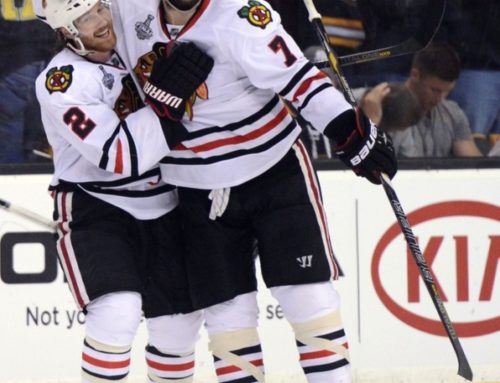
Once you've taken the leap into running a salary cap league, you're immediately faced with a crucial decision: will you use NHL salaries, or will you create a fantasy salary structure unique to your league? Both options present unique challenges and opportunities, both for your managers and for you as the commissioner.
Editor's Note: This is the second instalment in a series on managing a salary cap fantasy league. For the pros and cons of cap leagues, click here.
NHL Salaries
The most straightforward option is to adopt actual NHL player salaries (usually based on cap hit, which is consistent over the life of the contract, rather than the actual salary paid out in a given year, which can vary wildly). This is the most common type of salary cap league, and it's highly realistic, as GMs are playing with the same numbers as their real world counterparts. It adds a fun twist to the annual free agent frenzy – you'll be on pins and needles as you wait to find out not only what team your prized player will sign with, but perhaps more importantly, how much you're going to be on the hook for with their new contract.
A major advantage to this type of cap league is that many fantasy sites incorporate cap management based on NHL salaries. For instance, Fantrax allows you to enter your salary cap, and it will prevent teams from making roster moves and line-up changes that put them in violation of the cap. That takes a lot of the headache and number crunching out of policing the cap.
When you play with NHL contracts, everybody knows the cap hit associated with each player heading into the draft; it's not created on the fly. This certainly helps with pre-draft strategizing. On the other hand, in many cases a player's real life value may not translate well into fantasy value. You can argue amongst yourselves whether Jay Bouwmeester brings enough to the table to justify the $6.68 cap hit he costs the Flames, but in the fantasy world there are no ifs, ands or buts about it: J-Bo is a cap killer. He's an extreme example, but there are countless players whose high salaries owe more to the intangibles they offer than to the cold hard statistics that are rewarded in hockey pools. It's an inherent limitation in NHL salary-based fantasy games.
Another drawback when using NHL contract values is that your managers forsake all control over the most critical factor in building their teams, placing themselves at the mercy of the 30 men who run the NHL's teams. When Terry Pegula decides to prove himself by dropping $4.5 million at the feet of Ville Leino, it has crippling repercussions to Leino's fantasy owner. In a sense, you're shackling your team's fate to the whims of billionaire owners and their millionaire managers – for better or worse. For some, this factor just adds to the challenge and fun of running their team, but others may be turned off by the seeming arbitrariness of it all, and the need to adjust their roster in response to decisions outside of their control.
Fantasy Salaries
The alternative to using NHL salaries is to create custom fantasy salaries. There are a number of mechanisms for assigning contract values to players, but one of the most popular is through an auction-style draft. Rather than a traditional draft where teams take turns picking players, in an auction the players are put up for bid: highest bidder gets the player, and the winning bid amount becomes the salary. Many leagues build in an annual inflator, so the salary rises over time.
However the initial player salaries are determined, a major advantage to this system is that it gives your owners more control over the salary structure of their team. They won't have to scramble and change their team-building strategy just because some NHL GM with more money than common sense at his disposal decided to sign a middling player to an obscene contract. Instead, your managers can strategize and construct their squad with full assurance that they know what each player is going to cost them under your system.
Likewise, with this approach, player salaries will tend to reflect the player's fantasy value more accurately. He will be paid in accordance with his fantasy output, and he won't eat up more cap space just because he's good in the room or a solid shutdown d-man – qualities which earn players bigger contracts in the NHL, but which are generally irrelevant in fantasy leagues.
The obvious downside is that when you create your own salaries, the league becomes significantly more complicated to administer. Most hockey pool sites don't support this type of system, so you will have to track salaries and cap hits separately, using a spreadsheet or your own website. You will also have to be vigilant about keeping an eye on each team to watch for cap violations.
Ultimately, the system you choose comes down to your personal preference and that of the other managers in your league. Speaking for myself, if I had the time to administer a create-your-own-salary league, that would be my preference. It avoids the problem I faced last summer in one league that runs with NHL salaries. When Mikko Koivu signed for $6.75 million, it was more than my budget could bear. I have little doubt that Koivu is paid appropriately in the NHL universe; but in my fantasy world, if I'm going to spend nearly $7 million on a player, I need bigger numbers from him than Koivu provides. So I bid a fond farewell to my number one centre, and then had to make two more trades to plug the hole – all because the value that the Minnesota Wild placed on their franchise player didn't match his value to my fantasy squad.
Let's hear from you. Would you rather play in league that uses NHL salaries as the basis for its cap system, or would you prefer to create custom fantasy salaries?





 ANA
ANA CAR
CAR TOR
TOR VAN
VAN PIT
PIT S.J
S.J MIN
MIN COL
COL
